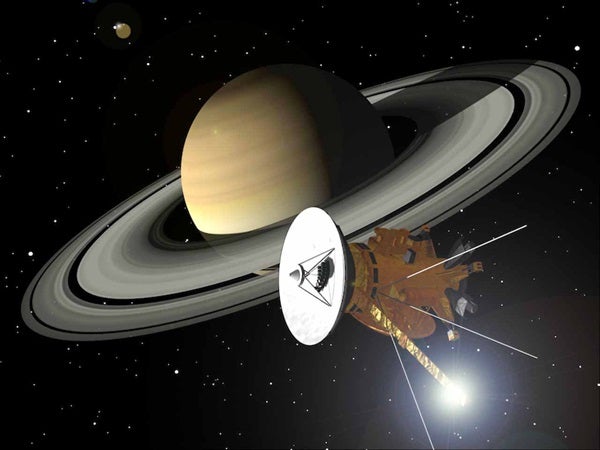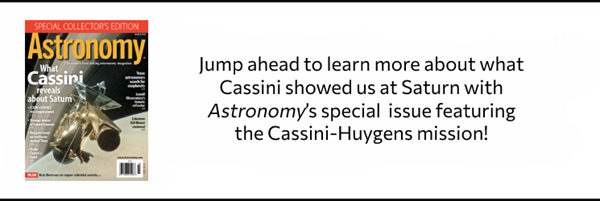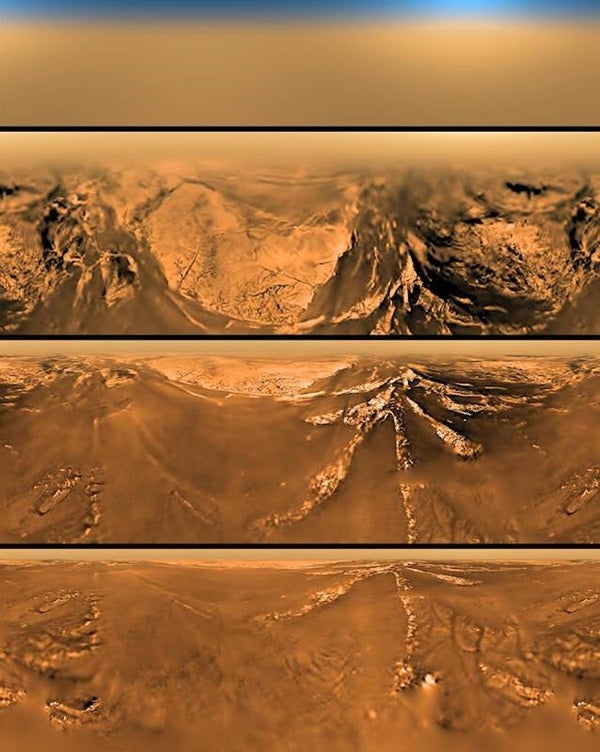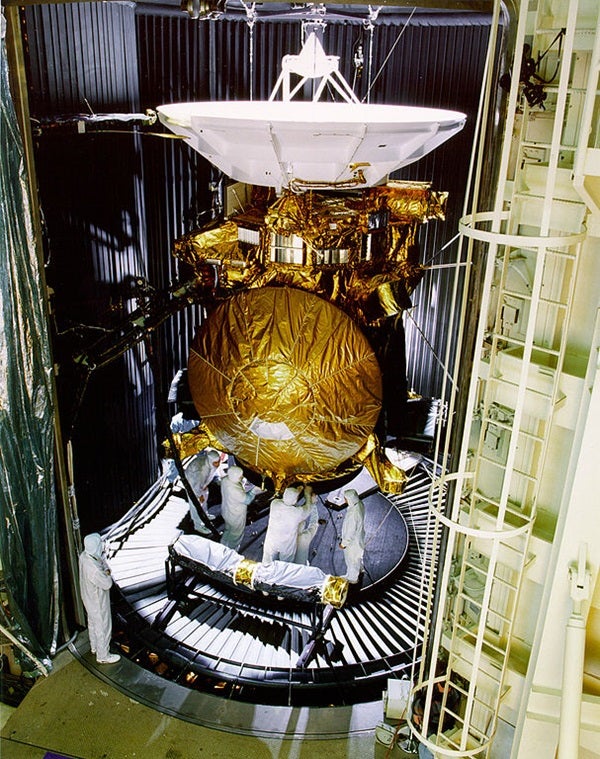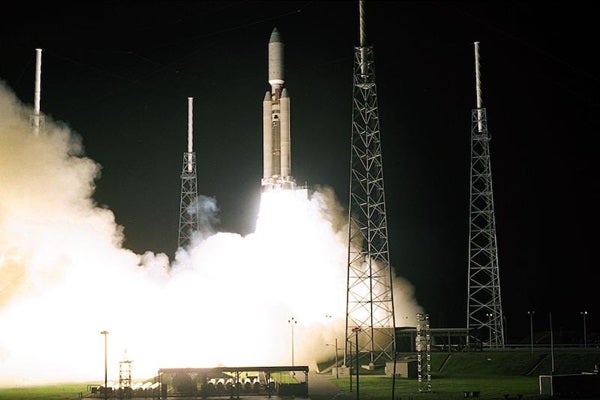Cassini-Huygens was an unprecedented foray into the unknown. It was not our first close-up glimpse of Saturn — the Pioneer 11, Voyager 1, and Voyager 2 probes had zipped by the planet in 1979, 1980, and 1981, respectively. But theirs were fast-paced flyby tours; scientists wanted a longer-term Saturn orbiter and Titan probe to truly explore the complex system.
To that end, 25 years ago, a mighty Titan IVB/Centaur rocket patiently sat in the predawn darkness of Cape Canaveral’s Launch Complex 40. More than 20 stories tall, the hammer-headed rocket had earned great renown as a launcher of top-secret spy satellites.
But that morning, for the only time in the rocket’s checkered career, a Titan was about to carry a scientific endeavor: the Cassini-Huygens mission.
A joint endeavor between NASA, the European Space Agency (ESA), and the Italian Space Agency (ASI), Cassini-Huygens would embark on a multi-year, multi-billion-mile trek into the gloomy and frigid reaches of the outer solar system. And when it finally arrived at butterscotch-hued Saturn, the second largest of the Sun’s planets, it transformed our understanding of this gas giant immeasurably.
Reaching for Saturn
Nine times wider and 95 times more massive than Earth, Saturn is a hydrogen and helium behemoth that resides far from our own life-friendly patch of cosmic real estate. Saturn’s roiling, storm-filled atmosphere, blustering 1,100 mph (1,770 km/h) equatorial winds, multitude of moons, and unique glittering rings — composed of trillions of unconnected, ice-encrusted particles — have captivated and intrigued astronomers for centuries.
In fact, two of those astronomers played such an important role in unveiling Saturn’s mysteries that they were honored by name with a landmark $3.26 billion mission.
Launch: Oct. 15, 1997 on a Titan IVB/Centaur rocket from Cape Canaveral, Florida
Venus flybys: April 26, 1998, at 176 miles (234 km) and June 24, 1999, at 370 miles (600 km)
Earth flyby: Aug. 18, 1999, at 727 miles (1,170 km)
Jupiter flyby: Dec. 30, 2000, at 6 million miles (10 million km)
Saturn arrival: July 1, 2004 (June 30 in California)
Giovanni Domenico Cassini (1625-1712) was an Italian-born, French-naturalized engineer, mathematician, and astronomer. He first identified a gap (the eponymous Cassini Division) between two of Saturn’s most prominent rings. Cassini also went on to discover four of Saturn’s moons, including peculiar, two-toned Iapetus.
Cassini’s name adorned the mission’s 22-foot-long (6.8-meter) NASA-built orbiter. The Cassini orbiter would ultimately circle Saturn 294 times between when it arrived at the gas giant in July 2004 (June 30 by the clocks at NASA’s Jet Propulsion Laboratory in Pasadena, California) and its Grand Finale in September 2017. Cassini scoured the planet in unrivaled detail using a dozen instruments, from visible, ultraviolet, and infrared sensors to radiometers, spectrometers, magnetometers, and a powerful radar imager.
Dutch physicist, astronomer, and mathematician Christiaan Huygens (1629-1695) was the namesake for an 9-foot-wide (2.7-meter) disk-shaped probe. The Huygens probe was built by the European Space Agency and designed to be dropped into the thick, hydrocarbon-soup atmosphere that cloaks Saturn’s largest moon, planet-sized Titan. (Titan is larger than Mercury and nearly the size of Mars.) After parachuting through Titan’s smoggy clouds in January 2005, the Huygens probe and its suite of six instruments triumphantly landed on a rocky surface never before seen by humanity, under a glowering orange sky.
Naming the probe for Huygens was especially fitting, as he had discovered Titan through his telescope eyepiece one spring evening in March 1655. The astronomer was also the first person to recognize Saturn’s rings for what they truly are — not sweeping arcs or handles or “ears,” as earlier astronomers such as Galileo Galilei had speculated, but rather a continuous disk of material around the planet.
A long road
Developing the joint mission moved with breathtaking pace, from workshop brainstorming sessions to formal endorsement by the National Academy of Sciences (NAS) in October 1985. This envisaged launching a notional Saturn/Titan mission as early as 1988. After consideration on both sides of the Atlantic, in 1988, Lennard Fisk, NASA’s head of space science and applications, approached his ESA counterpart Roger Bonnet with a proposal: NASA would happily commit to the mission if ESA did.
Following both sides’ agreement, NASA selected Cassini’s scientific payload in November 1990. Early the following spring, NASA Administrator Richard Truly and ESA Director-General Jean-Marie Luton inked a deal to collaborate on the mission, then targeted to launch no earlier than April 1996. Cassini passed its critical design review in December 1992, by which time the launch had shifted back to October-November 1997.
Dimensions: 22 feet (6.8 m) high, 13.1 feet (4 m) wide
Weight at launch: 12,593 pounds (5,712 kg) fully fueled with Huygens
These formative years proved exceptionally troubled ones, as an ever-present specter of Congressional budget cuts twice threatened Cassini’s cancellation. The mission’s international scope (and Europe’s sizeable financial investment) ultimately came to the rescue. ASI’s involvement in July 1994 added further international weight, and thereafter Cassini enjoyed relatively benign political waters.
But critics remained, most vocally within the anti-nuclear lobby, who opposed the 72 pounds (33 kilograms) of plutonium the spacecraft carried as a power source. (So far from the Sun, NASA argued, solar power was simply not as feasible.) They worried about safety if Cassini somehow flew off course on its circuitous route to Saturn and crashed into Earth. NASA’s October 1994 publication of an environmental impact assessment did little to assuage this dissent. Not until formal White House approval to proceed early in October 1997 did Cassini surmount its final barrier to launch.
Getting off the ground
The timing of this launch was critical. Cassini-Huygens was designed to reach Saturn under the most economical conditions for energy expenditure. Its seven-year trajectory was designed with gravitational boosts from two encounters with Venus in April 1998 and June 1999, one flyby of Earth in August 1999, and a close passage of Jupiter in December 2000. Achieving each of these planetary encounters — on time and on target — and deriving the best possible energy benefit this rendered the launch window extremely tight.
NASA wanted Cassini-Huygens off the ground between Oct. 6 and Nov. 4 to reach Saturn on schedule in July 2004. A contingency period extending to Nov. 15 remained available, though less ideal, since it would lengthen the flight duration, putting Cassini at Saturn between December 2004 and December 2005.
But as the launch window neared, gremlins again reared their unsightly heads. During a countdown demonstration test in early August 1997, a liquid hydrogen leak arose in the Titan IVB’s Centaur upper stage; fortuitously, it was fixed at the pad. But then, less than a month later, excessive airflow in the spacecraft’s cooling system caused minor damage to Huygens’ thermal insulation, requiring additional repairs.
Finally, at 4:43 A.M. EDT on Oct. 15, 1997, the staccato crackle of the Titan IVB’s two side-mounted solid rocket boosters shattered the predawn gloom. Pushing Cassini-Huygens off the pad with a thrust of 3.4 million pounds (1.5 million kg), their bright glare turned night into day (and set off numerous car alarms) above a sleeping Florida. “Liftoff of the Cassini Mission,” exulted the NASA launch commentator, “on a billion-mile trek to Saturn!”
For two minutes, the solid boosters flared in the darkness, powering the rocket to an altitude of about 40 miles (65 kilometers), by which point the rocket was little more than a dot of light on the horizon. Shortly before they burned out and separated, accompanied by a bright flash, the Titan’s liquid-fueled central core came alive to continue the climb to space. Lastly, the Centaur’s own engine ignited to heave Cassini-Huygens out of Earth’s orbit and on its way to Saturn.
The mission had come a long way in the two decades since its inception and had faced considerable trials along the way. But as Cassini-Huygens left its home planet behind that October morning and hunkered down for a lengthy cruise through deep space, its long voyage had only just begun. It would arrive at Saturn only after several years slingshotting through the solar system, sending back unprecedented views along the way. And when it reached its destination in 2004, it began a second grand exploratory adventure that would unveil the solar system’s second-largest planet in an entirely new light.

